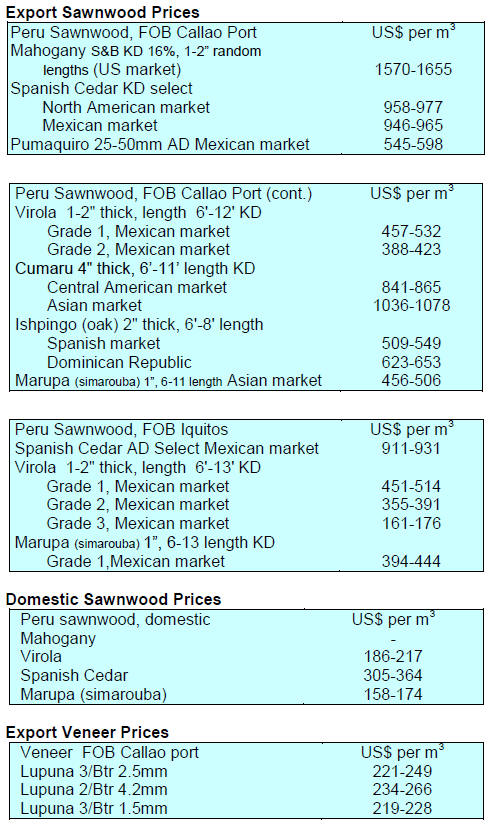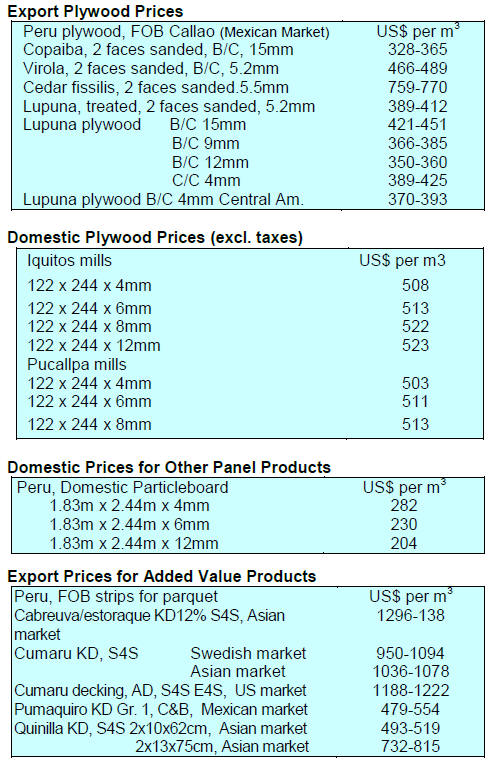2. GHANA
Healthy export growth in first seven
months
Ghana exported a total 207,051 cu.m of wood products
during the period January to July 2015 up 17% year on
year. The corresponding value for exports in the same
period was euro 105.77million, up 47% year on year.
The main export products in the January to July period
were sawnwood (air and kiln dry), plywood to regional
markets, teak poles and billets of teak, wawa, ceiba,
gmelina and papao/apa.
According to the Timber Industry Development Division
(TIDD) of the Forestry Commission the leading exporters
were Samartex Timber and Plywood Company Ltd., Logs
and Lumber Ltd., Reagent Industries Ghana Ltd., John
Bitar and Company Ltd. and Wular International
Company Ltd.
Ghana&s exports of wood products (mainly plywood) to
Nigeria could be threatened if a pending new regulation
from the Nigeria Central Bank is implemented.
It has been reported that this new regulation would
bar
importers of some specified goods, including wood
products, from accessing official Nigerian foreign
exchange markets. If the new regulation comes into force
importers will be required to look for alternative sources
of foreign exchange.
This plan by the Central Bank of Nigeria forms part of
measures to contain its fast-depleting foreign exchange
reserves. Nigeria is a major importer of Ghana&s wood
products particularly plywood.
AGI decries interest rate hike
At its latest Monetary Policy Committee meeting the Bank
of Ghana (BoG) increased interest rates from 24% to 25%.
In a press statement the Governor of BoG, Dr. Henry Kofi
Wampah, said 求the increase in the interest rate was based
on the Bank&s forecasts which showed the need for further
tightening to bring inflation within the target band by end
of 2016′.
Inflation in Ghana was 16.9% in May 2015 and jumped to
17.9% in July mainly due to increases in the local costs of
petroleum products and the impact of the weakening cedi.
In a statement the Association of Ghana Industries (AGI)
said it considered the decision by the BoG to increase
interest rates alarming as it will drive up the cost of
borrowing and will make access to credit even more
difficult. The AGI said this decision will further worsen
the plight of local manufacturing companies making them
even less competitive.
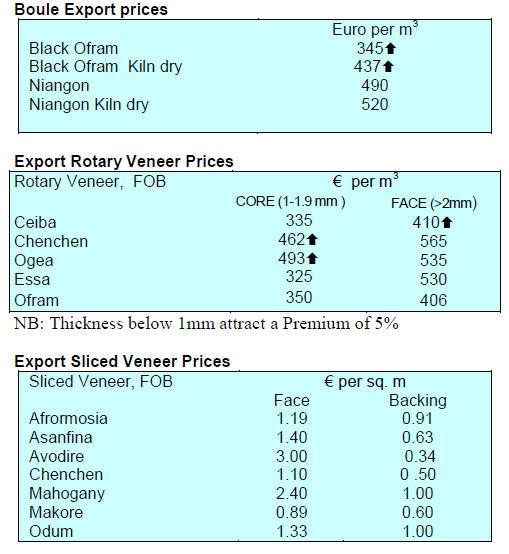
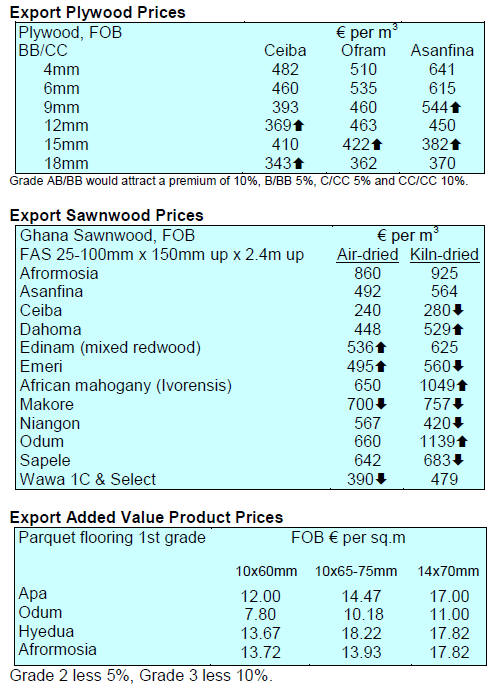
3. MALAYSIA
First half export performance
The Malaysian Timber Industry Board (MTIB) reported
timber sector exports of RM10.46 billion (approx. US$
3.77 billion) in the first half of the year. Wooden furniture
exports accounted for the biggest share of wood product
exports at RM3.33 billion (31.8% of the total).
Plywood exports ranked second at RM2.25 billion (21.5%)
followed by sawnwood exports at RM1.47 billion
(14.0%). Log exports comprised just under 10% of all
wood product exports at RM998 million in the first half of
this year.
Exports of wooden furniture were mainly from
manufacturers in Peninsular Malaysia. Furniture exports
from Sabah and Sarawak combined contributed barely 1%
to total furniture exports.
On the other hand, Sarawak is the biggest exporter of
plywood (918,286 cu.m or 72% of Malaysia&s total
plywood export) and exporters in Sabah shipped 248,500
cu.m accounting for another 20% of total plywood
exports.Plymills in Peninsular Malaysia shipped 102,280
cu.m or 8% of total plywood shipments.
Peninsular Malaysia was the leading exporter of
sawnwood at 636,340 cu.m followed by Sarawak 276,080
cu.m and Sabah 107,000.
Companies in Sarawak dominated the log export trade
by
Malaysia shipping around 1,388,900 cu.m or 88.7% of
total log exports in the first half of this year.
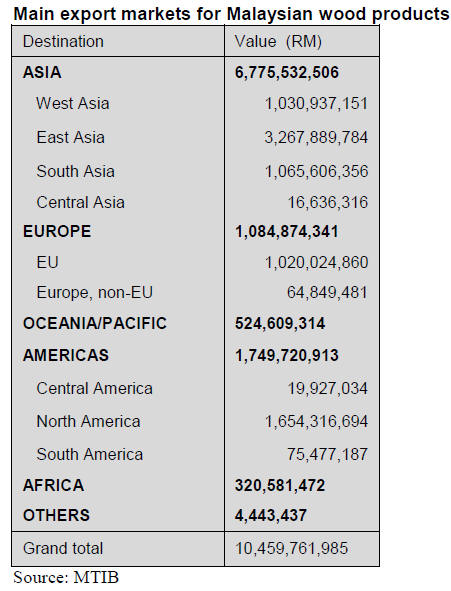
Regional markets the most important
Asian markets are the most important for Malaysian
timber exporters as they absorbed up 65% by value of all
exports. Japan alone took 17%, Republic of Korea and
Taiwan 5% each and China 4%. The EU accounted for
9.8% of total exports with the UK alone accounting for
3%. The USA imported 14% of Malaysian timber exports
while Australia imported 5%.
Sabah exports
The Sabah Department of Statistics released export data
for January to July 2015. Total wood product exports
totalled RM 915,287,733 (approx. US$ 208.4 million) and
comprised sawnwood at 22.8% of the total, lamin-board
4.5%, mouldings 3.3%, veneer 5.7% and plywood 63.7%.
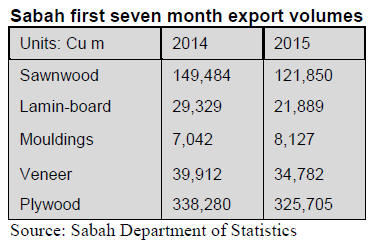
Sarawak log production falls in first half of
2015
Log production in Sarawak declined in the first half of this
year and four public-listed timber firms, Jaya Tiasa
Holdings, Subur Tiasa, Ta Ann and WTK, saw their log
output fall between 12% and 25% compared to the same
period last year.
Despite a drop in export volumes most companies report
good results from their log exports in the first half as price
increase were accepted in the main markets.
Exporter Ta Ann reported a 29% rise in April-June yearon-
year log export earnings and a 7% rise in earnings from
plywood sales.
Sarawak log production is expected to increase in the July-
September quarter which is the seasonal dry spell in
Sarawak. The dry weather facilitates felling operations.
Analysts report that the outlook for log exports is good as
India, which currently consumes about 60% of Sarawak&s
log supply, is expected to maintain a high level of imports
due the government spending on infrastructure and
construction projects
Plywood traders in Sarawak reported following FOB
export prices:
Floor base (FB) 11.5mm, US$590/ cu.m
Concrete formboard panels CP US$ 540/cu.m
Coated formboard panels UCP US$ 620/cu.m.
No sales were recorded to Middle East markets
4. INDONESIA
IFMAC 2015
IFMAC the International Furniture Manufacturing
Components Expo is regarded as one of the key event for
companies in the home decoration and wares business as
well as for furniture accessory suppliers and furniture
manufacturers. The 2015 trade show, fair and exhibition
attracted exhibitors and participants from 18 countries.
Sofianto Widjaja, General Manager of PT Wahana
Kemalaniaga Makmur the organizer said this exhibition
aimed at developing stronger industrial growth in furniture
manufacturing and wood processing in Indonesia.
At the same time a spokesperson for the Indonesian
Furniture and Handicraft Association (AMKRI) said the
exhibition addressed the needs of industry for information
on technological advances in the furniture component
industry.
Encouraging sales by Indonesian furniture makers at
Shanghai show
Indonesian furniture sold well at the 21st China
International Furniture Expo 2015 (CIFE 2015) in
Shanghai in late September. Media reports say business
concluded during the show was over US$3.5 million,
considerably higher than in either the 2013 or 2014 shows.
Timber sector deregulation to promote
competitiveness
According to Bachrul Chairi, the Director General of
International Trade Cooperation in the Ministry of Trade,
plans are being made for extensive deregulation in the
industrial sector and this could positively impact the
timber industry.
This new policy direction was announced at a recent
working group on trade and investment with EU.
Bachrul said efforts will be made to create an environment
where competitiveness improves in industrial sector so as
to attract investment in manufacturing.
Based on data from the Ministry of Trade, trade between
Indonesia and the EU between January to June 2015
amounted to just over US$13 billion, down by 10.7%
compared to the same period in 2014.
The average annual growth in trade between Indonesia and
EU over the past five years was a disappointing 1.1%.
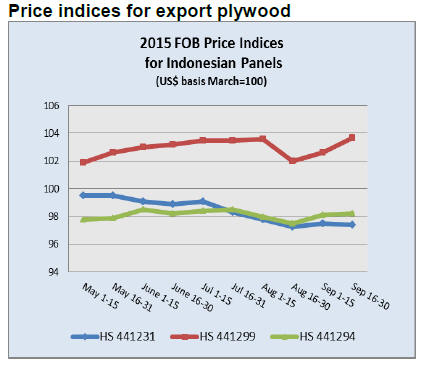
5. MYANMAR
How to verify legality of Myanmar*s
timber
Myanmar&s forestry ministry hosted a meeting with the
Global Timber Forum (GTF) with representation from the
International Wood Products Association (IWPA), the
European Timber Trade Federation (ETTF) and the
Australian Importers Federation (ATIF).
Officials from the Forestry Department, Myanma Timber
Enterprise (MTE) and the Myanmar Forest Products
Merchants Federation (MFPMF) also attended.
Discussions focused on finding the means to verify the
legally of Myanmar&s wood product exports.
For US companies direct import from Myanmar requires
permission from the US Government as trade between US
companies and MTE is not allowed but now the US
government is permitting trade but only by IWPA
members. The Myanmar government is now seeking the
lifting of the US trade restrictions.
Joint China-Myanmar discussion on illegal border
trade
A high level dialogue on the China/Myanmar timber trade
was held in Naypyitaw on 24 September. Myanmar was
represented by MOECAF Union Minister Win Tun, the
Director General of Forest Department, the Deputy
Director General, NGO&s and local businessmen.
The delegation from China was led by Fu Gui, Deputy
Director, Division of Development Planning and Fund
Management from China&s State Forestry Administration.
While there has been no official statement on the dialogue
the Myanmar press (Daily Eleven) reported that the
Chinese officials promised steps to combat the illegal
border trade, ensure legal trade and strengthen bilateral
relations. Myanmar&s Minister, Win Tun, told the
gathering that the illegal trade across the
Myanmar/Chinese border adversely affected the image of
both countries.
Analysts say that the Chinese forestry officials have to
report to authorities in Beijing before any concrete steps
can be taken.
The Chinese stated that from their part all logs entering
China for which taxes and custom duty is paid are
currently considered legal despite the fact that Myanmar
has imposed a log export ban. The press report said the
Chinese called on Myanmar to inform the Chinese
authorities on the border that a log export ban is in force
and as such all log exports are illegal under Myanmar law.
In response to the press reports analysts in Myanmar
expressed surprised when the Chinese delegation appeared
to be unaware that Myanmar has imposed a log export ban
which has been widely publicised.
Analysts in Myanmar welcome the decision by the
Chinese government to stop the entry of timber across the
Myanmar/Chinese border from 1 September to 31
December and hope that the Chinese authorities can effect
a sound reorganisation of the regional administration to
eliminate the illegal trade in timber over the
Myanmar/China border.
September Teak sales
The following timber was sold by Myanma Timber
Enterprise by tender on 24 September 2015.
Log volumes are expressed in hoppus tons (H.tons) and
volumes for ‗conversions& and sawn teak (including hewn
timber) are shown in cubic tons (C.tons).
For sawnwood longs (i.e. long lengths) are 6ft & up;
shorts (short lengths) are 3ft to 5.5ft; and ultras (ultra short
lengths) are 1ft to 2.5ft.
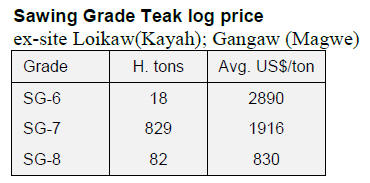

Note-
Tamalan- Dalbergia oliveri; Padauk- Ptrocarpus macrocarpus;
Sagawa- Michelia champca; Pyinkado- Xylia dolabiformis;
Kanyin-Dipterocarpus spp; In- Dipterocarpus tuberculatus;
Kaung Hmu-Anisoptera scaphula; Thitya-Shoreaoblongifolia
6.
INDIA
All eyes on opportunities in development
of smart
cities
According to a press release form the Federation of Indian
Chambers of Commerce and Industry (FICCI), Bruce
Andrews the US Deputy Secretary of Commerce will lead
a ‗smart cities& infrastructure business development
mission to India in next year with stops in Mumbai,
Chennai and Delhi in order to help US companies launch
or increase their business in India.
Andrews has said 求the smart cities agenda is a great
opportunity for the US and it offers immense opportunities
for cooperation between the US and India as the US has
the ability to create world-class infrastructure and possess
liquidity to finance long term projects.′
The objective of the US mission is to help US companies
increase business in India and will focus on technologies,
systems and services for safety and security, intelligent
transportation, water, wastewater and the power sector.
Both the US and India will benefit according to the FICCI
as the smart cities policy will contribute to a sustainable
growth of India's infrastructure sector.
For more see:
http://www.ficci.com/press-releases.asp
The concept of smart cities in India is explained in:
http://www.credai.org/sites/default/files/Conclave-2014-
Report-smart-cities.pdf
Inflation rate trends down
The Office of the Economic Adviser (OEA) to the Indian
government provides trends in the Wholesale Price Index
(WPI).
The official Wholesale Price Index for All Commodities
(Base: 2004-05 = 100) for August declined by 0.5% to
176.7 from 177.5 in July. The year on year annual rate of
inflation, based on monthly WPI, stood at -4.95%
(provisional) for August 2015 compared to -4.05% for
July.
For more see:
http://eaindustry.nic.in/cmonthly.pdf
Timber and plywood price indices climb
The OEA also reports Wholesale Price Indices for a
variety of wood products. The Wholesale Price Indices for
Wood products and Plywood are shown below.

The August price indices for wood and wood products
and
plywood continue to firm. The rise in the wood and wood
product price index was slightly more than that for
plywood where endusers are determinedly resisting efforts
by plywood manufacturers to raise prices.
See
http://eaindustry.nic.in/display_data.asp
Investment in lamination technology opens new
opportunities
Recent development in further processing of wood based
panels by Indian plywood and board manufacturers is
having a positive impact especially in the cabinet and
furniture making industries.
Until recently plywood makers only sold raw panels for
laminating elsewhere but now many panel makers have
invested in laminating equipment.
Kitchen furniture manufacturers were some of the first to
use pre-laminated panels and utilise mainly 16mm thick
products.
Analysts report that the professional laminating
undertaken by plywood and other panel mills has raised
the quality of laminates which are produced in a wide
range of finishes appreciated by consumers.
MDF manufacturers are following the lead of the
plywood sector and installing laminating lines to produce
boards with resistance to stains and water. The latest
overlays have been found easy to work mechanically.
These laminated panels are used in a wider range of
products.
The widespread introduction of pre-laminated boards has
contributed to the rapid expansion of flooring production
the use of which is growing rapidly in India.
As quality controls have been effective in the production
of laminated panels export opportunities are expanding
for components for cabinets etc.
Indian panel manufacturers have seen the advantages
from investing in the latest technology for more profitable
value added production. As analysts report 求There was a
time when domestic particleboard and MDF were not
appreciated by consumers as laminated panels produced
by small companies which purchased raw panels were
often poorly made and quickly failed in use.′
There has been a surge of investment by panel producers
which augurs well for the downstream wood working
industries.
Auction of domestic forest teak
In the most recent and last auction of the dry season some
35,000 cubic metres of mostly teak along with some other
hardwoods were offered for sales at Forest Depots in the
Dangs Division in the State of Gujarat.
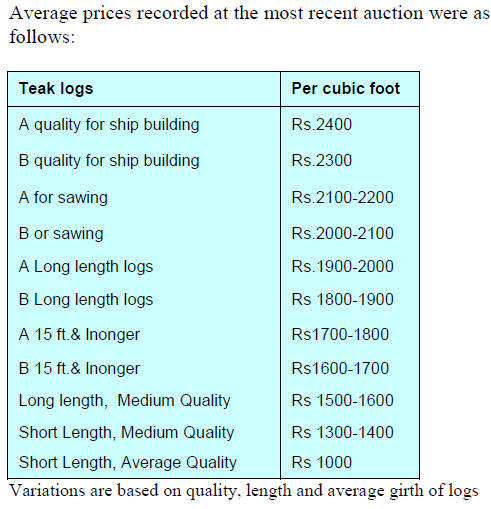
As is usual for the final auction of the season
buyers
turned out in record numbers however many log lots
remained unsold as prices were considered high relative to
the quality and dimensions of the logs offered.
The resistance of buyers to the high reserve prices for teak
was evident and analyst put this down to the growing
interest on the part of end-users and consumers in non-teak
hardwoods such as merbau, meranti and kapur which are
available at competitive prices.
Non-teak hardwood logs such as haldu (Adina cordifolia),
laurel (Terminalia tomentosa), kalam (Mitragyna
parviflora) and Pterocarpus marsupium were also
auctioned.
Good quality logs of these timbers with long lengths and
girths of 91cms & up attracted good prices in the range of
Rs. 600~800 per cu.ft while medium quality logs were
sold at between Rs.450 ~600 per cu. ft. Lower quality
hardwood logs were presold at between Rs.250 ~350 per
cu. ft.
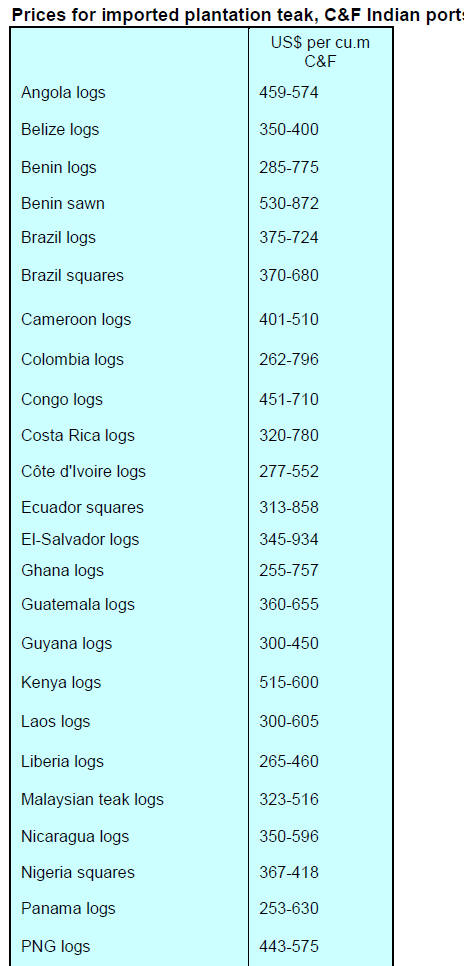
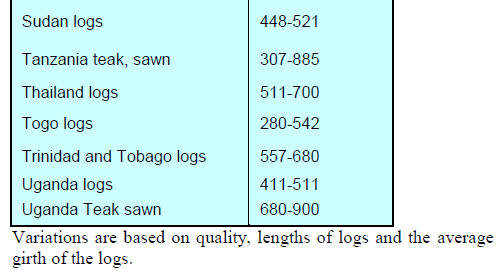
Prices for locally sawn hardwoods
Overall supplies and demand have been steady. The US
dollar/rupee exchange rate fluctuations have increased
landed costs but, so far, wholesalers have been absorbing
exchange losses such that prices have not changed in the
past month.

Millers of Myanmar teak unable to lift prices
There has been no change in price levels for domestically
milled Myanmar teak.
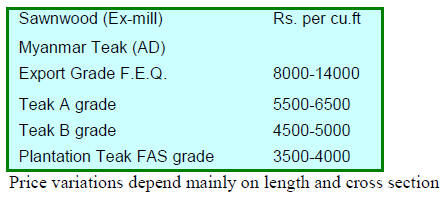
Prices for imported sawnwood
Exchnage rate fluctuations have hit sawnwood importers
and while prices have not changed over the past two
weeks price adjustments are anticipated in the near future.

7.
BRAZIL
ABIMCI pleads for stimulus for timber
companies
Given the current economic situation in the country
characterised by high inflation, high interest rates, high
taxes and rising unemployment, domestic consumption of
wood products has fallen sharply.
While recognizing there is no easy fix for this situation the
Brazilian Association of Mechanically-Processed Timber
Industry (ABIMCI) says a long term solution depends on
government investment in infrastructure and easing of the
tax burden on industry.
To seek solutions that ensure better conditions for
entrepreneurs ABIMCI offered some suggestions
including action at the Federal level to secure the redesignation
of duties on Brazilian exports to the US
(currently the US imposes a 8% duty on pine plywood
imports).
ABIMCI would also like the Federal government to
negotiate the exemption of import tax on Brazilian
plywood by Mexico, currently at 6%.
In addition ABIMCI would seek greater use of wood
products in government funded civil construction projects
and the elimination of the IPI tax (Tax on Industrialized
Products) on plywood (now levied at 5%.
Interest rates steadily advance to the dismay of
manufacturers
In September 2015 and for the seventh consecutive month
the Monetary Policy Committee (Copom) of the Central
Bank of Brazil decided to maintain the Selic rate at
14.25%.
Plywood and sawmilling industries returning to
profitability
The depreciation of the Brazilian currency against the US
dollar in recent months has favored Brazilian exports.
Because of this both the plywood and sawmilling
industries are gradually returning to profitability after
seven years of declining earnings. Both industrial sectors
are benefitting from expanded civil construction in the
United States.
Brazilian pine plywood export volumes to North America
increased 28%, from 14,249 cu.m in July this year to
18,204 cu.m in August. Of the total Brazilian pine
plywood exports in August this year 18% was exported to
the US market and 19% to Germany. On the other hand
August plywood exports to the UK, Belgium and Puerto
Rico fell.
In August Brazilian exports of wood-based products
(except pulp and paper) declined 6% in value year on year
from US$229,8 million to US$216,0 million.
Year on year pine sawnwood exports values grew 27% in
August to US$26 million and there was a 36% increase in
export volumes compared to a year earlier (87,200 cu.m to
118,700 cu.m).
Tropical sawnwood exports however, fell 22% in volume
in August, from 29,800 cu.m in August 2014 to 23,200
cu.m in August this year and the value of tropical
sawnwood exports declined just over 27% from US$15.7
million to US$ 11.4 million.
In the case of plywood, export values fell but export
volumes rose. The 6.5% drop in the value of exports from
US$ 35.4 million in August last year to US$ 33.1 million
this year was accompanied by a 7% increase in the volume
of exports (96,800 cu.m to 103,900 cu.m,).
In sharp contrast exports of tropical plywood increased
almost 32% in volume (5,700 cu.m in August 2014 to
7,500 cu.m in August 2015) and the value of tropical
plywood exports jumped 9% (US$3.3 million in August
2014 to US$3.6 million).
Disappointing wooden furniture exports compounded the
negative news on Brazil&s wood product export
performance, August 2015 wooden furniture exports
dropped almost 20% year on year.

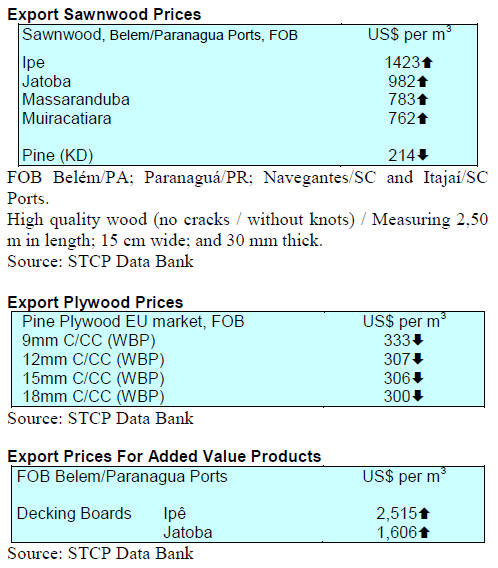
8. PERU
Financing mechanisms for the forestry
sector being
developed
The Agricultural Bank (Agrobanco) aims to expand its
financial services to the forestry sector so the private
sector is encouraged to invest in plantations.
Enrique Diaz, the head of the bank said forestry
investment is a special case as investment levels are
always high and the returns only accrue after a long time.
Despite this the bank wants to find a package of support
that will deliver the necessary financing for the private
sector while at the same time mitigating the risks
associated with long term investments.
In related news a mechanism for financing forest
plantations is being developed between state agencies and
the private sector and a plan for this will be launched in
the near future according to Piero Ghezzi , from the
Ministry of Production.
Ghezzi said the industry is working with the Development
Finance Corporation to lay the foundation for such a fund
taking into account the long term nature of such an
investment.
Ghezzi has reported that the group is very close to having
a plan for a workable package to strengthen forestry sector
investment.
In Peru it is estimated that between 10 to 15 million
hectares of natural forest have been deforested and that
some 17 million hectares are suitable for plantations.
Workshop on management of community forests
The Presidency of the Council of Ministers, the Common
Good Institute and the Native Community of Brillo Nuevo
Boras recently organised a workshop to exchange
experiences in community forest management.
The event was hosted by the Regional Government of
Loreto under its Regional Program for Management of
Forest Resources and Wildlife and was supported by the
US Forest Service Peru through its Forest Sector Initiative
and the Research Institute of the Peruvian Amazon.
The workshop utilised a participatory training model
named "the forest backpack" through which experiences in
forest inventory, forest management instruments and
identification of forest species were shared.
Participants were also introduced to practical techniques
for logging and measurement of standing trees, logs and
sawnwood to help strengthen the capacity of indigenous
communities linked to community forest management.
